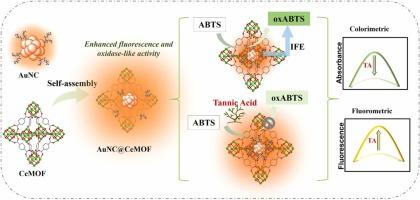一个MOF的双重功能:量身定制的AuNC@MOF杂交品种,具有协同氧化酶模拟活性和荧光扩增,可用于多模态单宁酸感应
IF 3.7
1区 化学
Q1 CHEMISTRY, ANALYTICAL
引用次数: 0
摘要
多模目标检测传感器由于其精度和通用性的提高而得到了广泛的关注。在本研究中,通过自组装制备了一种荧光纳米酶复合物(AuNC@CeMOF),将橙色发光金纳米团簇(AuNC)与具有内在氧化酶样活性的铈基金属有机骨架(CeMOF)结合在一起。值得注意的是,由于CeMOF的约束作用,AuNC的荧光特性得到了显著增强,提高了传感器的性能。在优化条件下,双模传感平台利用AuNC@CeMOF的氧化酶模拟活性和增强荧光,实现了对单宁酸(TA)的高灵敏度检测。该传感器具有线性响应范围和超低检测限,超越了许多传统方法。此外,基于智能手机的分析集成促进了便携式现场TA检测。这项工作强调了通过协同荧光增强和酶模拟特性来设计多功能纳米酶复合材料的可行性,为复杂样品中TA的鉴别和定量提供了一种有前途的策略。本文章由计算机程序翻译,如有差异,请以英文原文为准。

Dual-functionality in one MOF: Tailored AuNC@MOF hybrids with synergistic oxidase-mimetic activity and fluorescence amplification for multi-modal tannic acid sensing
The development of multi-mode sensors for target detection has gained significant attention due to their enhanced accuracy and versatility. In this study, a fluorescent nanozymes composite (AuNC@CeMOF) was fabricated via self-assembly, combining orange-emitting gold nanoclusters (AuNC) with the cerium-based metal-organic framework (CeMOF) exhibiting intrinsic oxidase-like activity. Notably, the fluorescence properties of AuNC were significantly enhanced due to the confinement effect of CeMOF, improving sensor performance. Under optimized conditions, the dual-mode sensing platform, leveraging both the oxidase-mimicking activity and the enhanced fluorescence of AuNC@CeMOF, enabled the highly sensitive detection of tannic acid (TA). The sensor demonstrated a linear response range and an ultra-low detection limit, surpassing many conventional methods. Furthermore, the integration of smartphone-based analysis facilitated portable, on-site TA detection. This work highlights the feasibility of designing multifunctional nanozyme composites by synergizing fluorescence enhancement and enzyme-mimicking properties, offering a promising strategy for the discrimination and quantification of TA in complex samples.
求助全文
通过发布文献求助,成功后即可免费获取论文全文。
去求助
来源期刊

Sensors and Actuators B: Chemical
工程技术-电化学
CiteScore
14.60
自引率
11.90%
发文量
1776
审稿时长
3.2 months
期刊介绍:
Sensors & Actuators, B: Chemical is an international journal focused on the research and development of chemical transducers. It covers chemical sensors and biosensors, chemical actuators, and analytical microsystems. The journal is interdisciplinary, aiming to publish original works showcasing substantial advancements beyond the current state of the art in these fields, with practical applicability to solving meaningful analytical problems. Review articles are accepted by invitation from an Editor of the journal.
 求助内容:
求助内容: 应助结果提醒方式:
应助结果提醒方式:


